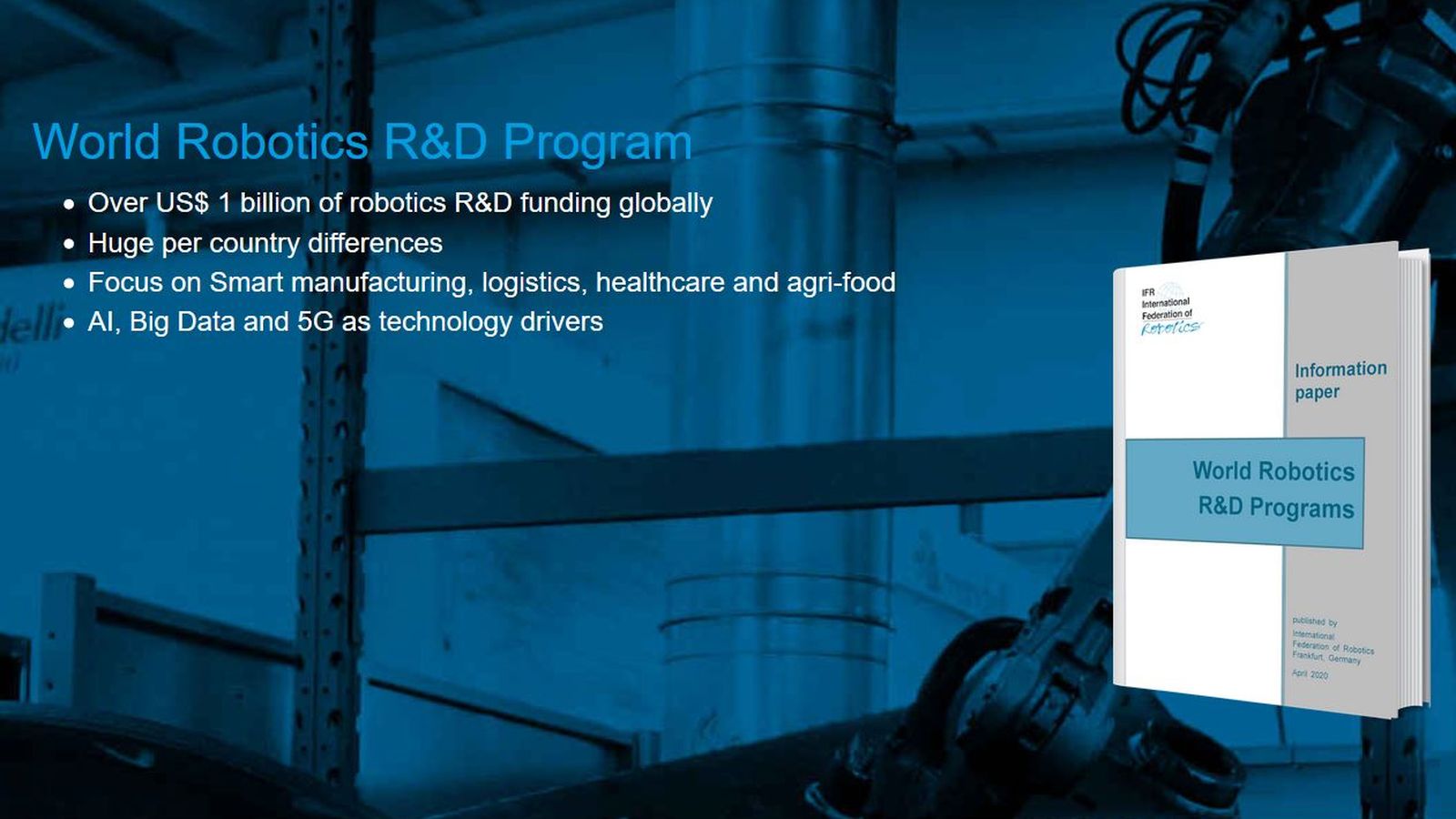IFR报告:各国如何投资机器人研发
http://www.gkong.com 2020-06-15 16:49 《中华工控网》翻译
IFR Report: How nations invest in robotics research
IFR报告:各国如何投资机器人研发
The Corona crisis highlights the important contribution that robots make to industry and to society. Research funding programs (R&D) are vital to enable and further support these developments: New technologies, such as Artificial Intelligence, Big Data and 5G, drive government funding in Asia, Europe and America. What are the targets of the officially driven government research funding programs and what can we learn from these findings? This has been researched by the International Federations of Robotics and published in the new paper “World Robotics R&D Programs” by IFR.
新冠危机凸显了机器人对产业和社会的重要贡献。研究资助计划(R&D)对于推动和进一步支持这些发展至关重要:人工智能、大数据和5G等新技术推动了亚洲、欧洲和美国的政府资助。官方推动的政府研究资助计划的目标是什么?我们可以从这些发现中学到什么?国际机器人联合会(IFR)对此进行了研究,并在其新论文《世界机器人研发计划》中发表。

“Each country has its own characteristics of robot programs based on its specific background and history,” says Prof. Dr. Jong-Oh Park, Vice-Chair IFR Research Committee and member of the Executive Board. “Therefore, we see that robotics programs set up by the most advanced robotics countries have a very different strategic focus.”
“基于特定的背景和历史,每个国家都有自己的机器人项目特点,” IFR研究委员会副主席兼执行委员会委员Jong-Oh Park教授说。 “因此,我们看到由最先进的机器人国家制定的机器人计划具有显著不同的战略重点。”
The strategic plan Made in China 2025 comes as a blueprint to upgrade the manufacturing capabilities of Chinese industries. This includes advanced robots among the top 10 core industries. The Robot Industry Development Plan sets out the goals for China in 2020, including: (1) developing three to five globally competitive robot manufacturers, (2) creating eight to ten industrial clusters, (3) achieving 45% of domestic market share for China's high-end robots, and (4) increasing China’s robot density to 100 robots per 10,000 workers. The statistical yearbook "World Robotics" by IFR shows that China reached a robot density of 140 units per 10,000 workers in the manufacturing industry in 2018. In 2019, the Chinese government invested 577 million USD in the development of intelligent robots.
《中国制造2025》战略计划是提升中国工业制造能力的蓝图。其中包括十大核心产业中的先进机器人。《机器人产业发展计划》设定了2020年中国的目标,其中包括:(1)发展三到五家具有全球竞争力的机器人制造商;(2)创建八到十个产业集群;(3)实现中国高端机器人45%的国内市场份额;(4)将中国的机器人密度提高到每万名工人100台机器人。国际机器人联合会的《世界机器人》统计年鉴显示,2018年中国制造业的机器人密度达到每万名工人140台。2019年,中国政府投资5.77亿美元用于开发智能机器人。
The New Robot Strategy in Japan is a key policy of the Abenomics Growth Strategy. The robot-related budget for 2019 has been increased to 351 million USD, with the aim to to make Japan the robot innovation hub in the world. The action plan includes manufacturing as well as important service sectors like healthcare, agriculture and infrastructure. According to the statistical yearbook "World Robotics" by IFR, Japan is the world´s number one industrial robot manufacturer and delivered 52% of the global supply in 2018.
日本的《机器人新战略》是安倍经济学增长战略的一项重要政策。2019年与机器人相关的预算已增加至3.51亿美元,旨在使日本成为全球机器人创新中心。该行动计划包括制造业以及重要的服务部门,例如医疗保健、农业和基础设施。根据国际机器人联合会的《世界机器人》统计年鉴,日本是全球第一大工业机器人制造国,2018年占全球供应量的52%。
The Intelligent Robot Development and Supply Promotion Act of Korea is pushing to develop the robot industry in Korea as a core industry in the fourth industrial revolution. The 3rd basic plan for Intelligent Robots published in 2019 promotes systematic selection and concentration of promising public and private sectors. Focus areas are: manufacturing businesses, selected service robot areas (including healthcare and logistics), next-generation key components and key robot software. The robot-related budget for 2020 is 126 million USD (151 billion won). The statistical yearbook "World Robotics" showed a new record stock of about 300,000 operational industrial robots in the Republic of Korea in 2018 (+10%). Within five years, the country has doubled its number of industrial robots in operation. Following Japan and China, the country ranked third in 2018.
韩国的《智能机器人开发与供应促进法》正在推动将韩国的机器人产业发展为第四次工业革命的核心产业。 2019年发布的第三版“智能机器人基本计划”促进了有前途的公共和私营部门的系统选择和集中。重点领域包括:制造业务、选定的服务机器人领域(包括医疗保健和物流)、下一代关键组件和关键机器人软件。2020年机器人相关预算为1.26亿美元(1510亿韩元)。《世界机器人》统计年鉴显示,2018年韩国约有30万台可操作工业机器人,创下新的记录(增长了10%)。在五年之内,该国已投入使用的工业机器人数量翻了一番。仅次于日本和中国,韩国在2018年全球排名第三。
Robotics projects funded by Horizon 2020, the European Union´s 8th Framework Program, represent a wide variety of research and innovation topics – ranging from manufacturing, commercial and healthcare use to consumer, transportation, and agri-food robotics. Through this program, EC provides an estimated 780 million USD funding for robotics research and innovation over its seven-year runtime. The main topics of the Work Program 2018-2020 are related to digitization of industry through robotics, robotics applications in promising new areas, and robotics core technologies such as AI and cognition, cognitive mechatronics, socially cooperative human-robot interaction, and model-based design and configuration tools with the total budget of 173 million USD.
由欧盟第八框架计划——“地平线2020”计划(Horizon 2020)资助的机器人项目代表了广泛的研究和创新主题——从制造业、商业和医疗保健应用到消费者、运输和农业食品机器人。通过这个项目,欧洲委员会在七年的运行时间里为机器人研究和创新提供了大约7.8亿美元的资金。《2018-2020年工作计划》的主要议题涉及通过机器人技术实现工业数字化,机器人技术在有希望的新领域的应用,以及机器人技术核心技术,如人工智能和认知、认知机电一体化、社会合作人机交互以及基于模型的设计和配置工具,总预算为1.73亿美元。
As part of its High-Tech Strategy, Germany support the use of new digital technologies within industry and administration. The “PAiCE” program with a funding budget of 55 million USD (50 million euros) over five years emphasizes the development of digital industry platforms as well as collaboration between companies using these platforms. In particular, the robotics-oriented projects are focusing on the creation of platforms for service robotics solutions in the various relevant application areas including service, logistics, and manufacturing fields. Germany is the fifth largest robot market in the world and number one in Europe, followed by Italy and France. In 2018, the number of robots sold increased by 26% to almost 27,000 units – a new all-time record.
作为其高科技战略的一部分,德国支持在产业和行政管理中使用新的数字技术。“ PAiCE”计划的五年预算为5500万美元(5000万欧元),着重于数字产业平台的开发以及使用这些平台公司之间的合作。特别是,面向机器人技术的项目侧重于在服务、物流和制造领域等各种相关应用领域中创建服务机器人解决方案平台。德国是世界第五大机器人市场,在欧洲排名第一,其次是意大利和法国。2018年,德国售出的机器人数量增长了26%,约为2.7万台,创历史新高。
The National Robotics Initiative (NRI) in the USA was launched for fundamental robotics R&D supported by the US Government. The main goals focus on fundamental science, technologies, and integrated systems needed to achieve a vision of ubiquitous collaborative robots assisting humans in every aspect of life. Moreover, in NRI-2.0, collaboration between academia, industry, non-profit, and other organizations is encouraged. The budget of NRI for 2019 is 35 million dollars. Additional robotics funding for application in defense and space is provided through the Department of Defense (DoD) and the Mars Exploration Program. According to the statistical yearbook "World Robotics", robot installations in the United States increased for the eighth year in a row to a new peak in 2018. Regarding annual installations, the country has taken third position from the Republic of Korea.
在美国政府的支持下,美国启动了《国家机器人计划》(NRI)进行基础机器人技术的研发。 主要目标集中于基础科学、技术和集成系统,以实现无处不在的协作机器人在生活的各个方面帮助人类的愿景。此外,在《国家机器人计划2.0》中,鼓励学术界、工业界、非营利组织和其他组织之间的合作。2019年《国家机器人计划》的预算是3500万美元。 美国国防部和“火星探索计划”(Mars Exploration Program)为在国防和太空领域应用的机器人技术提供了额外的资金。根据《世界机器人》统计年鉴,美国的机器人安装量连续第八年增长,在2018年达最高峰。就年度安装量而言,美国超越韩国位居全球第三。
相关新闻
- ▪ 普渡D5在全球首个机器人登高挑战赛中斩获轮式四足机器人组冠军
- ▪ 李强总理到广东调研,越疆科技创始人刘培超展示汇报具身机器人创新成果
- ▪ 2026大湾区智能机器人博览会(IR Expo深圳),直通机器人产业应用聚集地!
- ▪ 以“正向设计”蓄势品质突围,美的威灵机器人部件领创核心部件国产化突破
- ▪ 波士顿动力发布企业级Atlas机器人,携手DeepMind赋能工业新未来
- ▪ 新松机器人荣耀亮相“筑基强国路—中国制造‘十四五’成就展”
- ▪ 节卡机器人亮相重庆电子学会SMT/MPT专委会2026工作会
- ▪ 新年开工首日 智能机器人粤企铆劲赶工
- ▪ 2026年中国工业机器人市场规模预测
- ▪ 新松机器人在天津打造全国制造基地,助力汽车生产效率提升
编辑精选
工控原创
- ▪ 经典焕新,实力跃升:西门子 S7-200 SMART G2 系列正式登场
- ▪ 波士顿动力发布企业级Atlas机器人,携手DeepMind赋能工业新未来
- ▪ 12 月工业自动化月度焦点回顾,辞旧迎新启新程!
- ▪ 统一以太网标准再迎里程碑,SPE 和 Ethernet-APL 解锁工业数字化新机遇
- ▪ 11月RatingDog中国制造业PMI降至49.9,供需走弱重回收缩区间
- ▪ 11月工控圈发生了这些瞩目的大事件
- ▪ 十月工控领域重要资讯,一睹为快!
- ▪ 回顾 | 以技术干货 + 落地案例,解锁产业升级新路径
- ▪ ABB报告:工业停机每小时损失高达50万美元,知行鸿沟阻碍现代化更新
- ▪ ABB宣布以53.75亿美元将机器人业务出售给软银




